Comparative Assessment to Predict and Forecast Water-Cooled Chiller Power Consumption Using Machine Learning and Deep Learning Algorithms
Abstract
1. Introduction
2. Methods
2.1. Overview of Proposed Approach
2.2. The Basic Concepts of Machine Learning and Deep Learning
2.3. Power Consumption Prediction Model
2.3.1. Thermodynamic Model
2.3.2. Multi-Layer Perceptron (MLP)
2.4. Time-Series Forecasting Models
2.4.1. Multi-Layer Perceptron (MLP)
2.4.2. One-Dimensional Convolutional Neural Network (1D-CNN)
2.4.3. Long-Short Term Memory (LSTM)
2.5. Performance Evaluation
3. Experiments and Result
3.1. Physical Equipment
3.2. Software and Hardware
3.3. Data Description
3.4. Power Consumption Prediction
3.4.1. Thermodynamic Model
3.4.2. Multi-layer Perceptron (MLP)
3.4.3. Power Consumption Prediction Model Performance Comparison
3.5. Time-Series Forecasting Model
3.5.1. Three Deep Learning Algorithms
3.5.2. Time-series Forecasting Model Performance Comparison
4. Conclusions
Author Contributions
Funding
Data Availability Statement
Acknowledgments
Conflicts of Interest
Nomenclature
| AI | Artificial intelligence |
| ANN | Artificial neural network |
| COP | Coefficient of performance |
| HVAC | Heating, ventilating and air conditioning |
| LR | Linear regression |
| LSTM | Long short-term memory |
| MAE | Mean absolute error |
| MLR | Multi-variable linear regression |
| MSE | Mean squared error |
| ReLU | Rectifier linear unit |
| RMSE | Root mean square error |
| RNN | Recurrent neural network |
| SSE | Sum of square error |
| SVM | support vector machine |
| SVR | Support vector regression |
| 1D-CNN | One-dimensional convolutional neural network |
| α | Alpha |
| β | Beta |
| Bias | |
| Bias for represent candidate for cell state | |
| Bias for forget gate | |
| Bias for input gate neurons | |
| Bias for output gate neurons | |
| Cell state (memory) | |
| Cell state (memory) from the previous block | |
| Represent candidate for cell state at timestamp | |
| Nonlinear activation function | |
| Forget gate | |
| Hidden state at time | |
| Output from the previous block | |
| Input gate | |
| Number of samples | |
| Output gate | |
| Compressor energy usage | |
| Predictive value | |
| Evaporator load | |
| R2 | Coefficient of determination |
| Standard deviation | |
| Evaporator water return temperature | |
| Chilled water supply temperature | |
| Condenser water return temperature | |
| Condenser water supply temperature | |
| Evaporator water velocity | |
| Condenser water velocity | |
| Weight for represent candidate for cell state | |
| Weight for forget gate neurons | |
| Weight at the recurrent neuron | |
| Weight at the output neuron | |
| Weight for input gate neurons | |
| Weight for output gate neurons | |
| Weight at the input neuron | |
| Weight for neurons | |
| Weight indicates the slope value | |
| Weight indicates the intercept value | |
| Input at current step | |
| Independent variable | |
| Input variable | |
| Observed data | |
| Sample mean | |
| Largest value of observed data | |
| Smallest value of observed data | |
| Normalized data | |
| Standardized data | |
| Measured value | |
| Output state | |
| Average measured value | |
| Dependent variable or neuron output | |
| Measured value in observation | |
| Predicted value for observation | |
| Sigmoid function |
References
- Somu, N.; Raman, M.R.G.; Ramamritham, K. A hybrid model for building energy consumption forecasting using long short term memory networks. Appl. Energy 2020, 261, 114131. [Google Scholar] [CrossRef]
- Liu, T.; Xu, C.; Guo, Y.; Chen, H. A novel deep reinforcement learning based methodology for short-term HVAC system energy consumption prediction. Int. J. Refrig. 2019, 107, 39–51. [Google Scholar] [CrossRef]
- Kim, T.-Y.; Cho, S.-B. Predicting residential energy consumption using CNN-LSTM neural networks. Energy 2019, 182, 72–81. [Google Scholar] [CrossRef]
- Nasruddinn, N.; Sholahudin, S.; Satrio, P.; Mahlia, T.M.I.; Giannetti, N.; Saito, K. Optimization of HVAC system energy consumption in a building using artificial neural network and multi-objective genetic algorithm. Sustain. Energy Technol. Assess. 2019, 35, 48–57. [Google Scholar] [CrossRef]
- Xiong, W.; Wang, J. A semi-physical static model for optimizing power consumption of HVAC systems. Control Eng. Pract. 2020, 96, 104312. [Google Scholar] [CrossRef]
- Sala-Cardoso, E.; Delgado-Prieto, M.; Kampouropoulos, K.; Romeral, L. Predictive chiller operation: A data-driven loading and scheduling approach. Energy Build. 2020, 208, 109639. [Google Scholar] [CrossRef]
- Yu, J.; Liu, Q.; Zhao, A.; Qian, X.; Zhang, R. Optimal chiller loading in HVAC System Using a Novel Algorithm Based on the distributed framework. J. Build. Eng. 2020, 28, 101044. [Google Scholar] [CrossRef]
- Ahmad, M.W.; Mourshed, M.; Rezgui, Y. Trees vs Neurons: Comparison between random forest and ANN for high-resolution prediction of building energy consumption. Energy Build. 2017, 147, 77–89. [Google Scholar] [CrossRef]
- Pombeiro, H.; Santos, R.; Carreira, P.; Silva, C.; Sousa, J.M.C. Comparative assessment of low-complexity models to predict electricity consumption in an institutional building: Linear regression vs. fuzzy modeling vs. neural networks. Energy Build. 2017, 146, 141–151. [Google Scholar] [CrossRef]
- García-Sanz-Calcedo, J.; Gómez-Chaparro, M. Quantitative analysis of the impact of maintenance management on the energy consumption of a hospital in Extremadura (Spain). Sustain. Cities Soc. 2017, 30, 217–222. [Google Scholar] [CrossRef]
- Sha, H.; Xu, P.; Hu, C.; Li, Z.; Chen, Y.; Chen, Z. A simplified HVAC energy prediction method based on degree-day. Sustain. Cities Soc. 2019, 51, 101698. [Google Scholar] [CrossRef]
- Wang, J.Q.; Du, Y.; Wang, J. LSTM based long-term energy consumption prediction with periodicity. Energy 2020, 197, 117197. [Google Scholar] [CrossRef]
- Qing, X.; Niu, Y. Hourly day-ahead solar irradiance prediction using weather forecasts by LSTM. Energy 2018, 148, 461–468. [Google Scholar] [CrossRef]
- Wang, H.; Lei, Z.; Zhang, X.; Zhou, B.; Peng, J. A review of deep learning for renewable energy forecasting. Energy Convers. Manag. 2019, 198, 111799. [Google Scholar] [CrossRef]
- Pal, A.; Prakash, P.K.S. Practical Time Series Analysis; Packt: Birmingham, UK, 2017; pp. 161–204. [Google Scholar]
- Zhong, H.; Wang, J.; Jia, H.; Mu, Y.; Lv, S. Vector field-based support vector regression for building energy consumption prediction. Appl. Energy 2019, 242, 403–414. [Google Scholar] [CrossRef]
- Cannistraro, G.; Cannistraro, M.; Restivo, R. Some Observations on The Radiative Exchanges Influence on Thermal Comfort in Rectangular Open-Space Environments. Int. J. Heat Technol. 2015, 33, 79–84. [Google Scholar] [CrossRef]
- Cannistraro, G.; Cannistraro, M.; Restivo, R. The Local Media Radiant Temperature for the Calculation of Comfort in Areas Characterized by Radiant Surfaces. Int. J. Heat Technol. 2015, 33, 115–122. [Google Scholar] [CrossRef]
- Wen, L.; Zhou, K.; Yang, S. Load demand forecasting of residential buildings using a deep learning model. Electr. Power Syst. Res. 2020, 179, 106073. [Google Scholar] [CrossRef]
- Zhang, G.; Guo, J. A novel ensemble method for hourly residential electricity consumption forecasting by imaging time series. Energy 2020, 203, 117858. [Google Scholar] [CrossRef]
- Kim, M.; Jung, S.; Kang, J. Artificial Neural Network-Based Residential Energy Consumption Prediction Models Considering Residential Building Information and User Features in South Korea. Sustainability 2019, 12, 109. [Google Scholar] [CrossRef]
- Le Cam, M.; Zmeureanu, R.; Daoud, A. Cascade-based short-term forecasting method of the electric demand of HVAC system. Energy 2017, 119, 1098–1107. [Google Scholar] [CrossRef]
- Kim, M.K.; Kim, Y.-S.; Srebric, J. Predictions of electricity consumption in a campus building using occupant rates and weather elements with sensitivity analysis: Artificial neural network vs. linear regression. Sustain. Cities Soc. 2020, 62, 102385. [Google Scholar] [CrossRef]
- He, Y.; Zheng, Y.; Xu, Q. Forecasting energy consumption in Anhui province of China through two Box-Cox transformation quantile regression probability density methods. Measurement 2019, 136, 579–593. [Google Scholar] [CrossRef]
- Hu, H.; Wang, L.; Peng, L.; Zeng, Y.-R. Effective energy consumption forecasting using enhanced bagged echo state network. Energy 2020, 193, 116778. [Google Scholar] [CrossRef]
- Sendra-Arranz, R.; Gutiérrez, A. A long short-term memory artificial neural network to predict daily HVAC consumption in buildings. Energy Build. 2020, 216, 109952. [Google Scholar] [CrossRef]
- Markou, M.; Kyriakides, E.; Polykarpou, M. 24-Hour Ahead Short Term Load Forecasting Using Multiple MLP. In Proceedings of the International Workshop on Deregulated Electricity Market Issues in South-Eastern Europe, Nicosia, Cyprus, 22–23 September 2008. [Google Scholar]
- Amarasinghe, K.; Marino, D.L.; Manic, M. Deep neural networks for energy load forecasting. In Proceedings of the 2017 IEEE 26th International Symposium on Industrial Electronics (ISIE), Edinburgh, UK, 19–21 June 2017; pp. 1483–1488. [Google Scholar]
- Kontogiannis, D.; Bargiotas, D.; Daskalopulu, A. Minutely Active Power Forecasting Models Using Neural Networks. Sustainability 2020, 12, 3177. [Google Scholar] [CrossRef]
- Kim, J.; Hwangbo, H. Real-Time Early Warning System for Sustainable and Intelligent Plastic Film Manufacturing. Sustainability 2019, 11, 1490. [Google Scholar] [CrossRef]
- Cannistraro, G.; Cannistraro, M.; Trovato, G. Islands “Smart Energy” for eco-sustainable energy a case study “Favignana Island”. Int. J. Heat Technol. 2017, 35, S87–S95. [Google Scholar] [CrossRef]
- Wang, P.; Fan, E.; Wang, P. Comparative Analysis of Image Classification Algorithms Based on Traditional Machine Learning and Deep Learning. Pattern Recognit. Lett. 2020, S0167865520302981. [Google Scholar] [CrossRef]
- Keras. The Python Deep Learning API. Available online: https://keras.io/ (accessed on 17 September 2020).



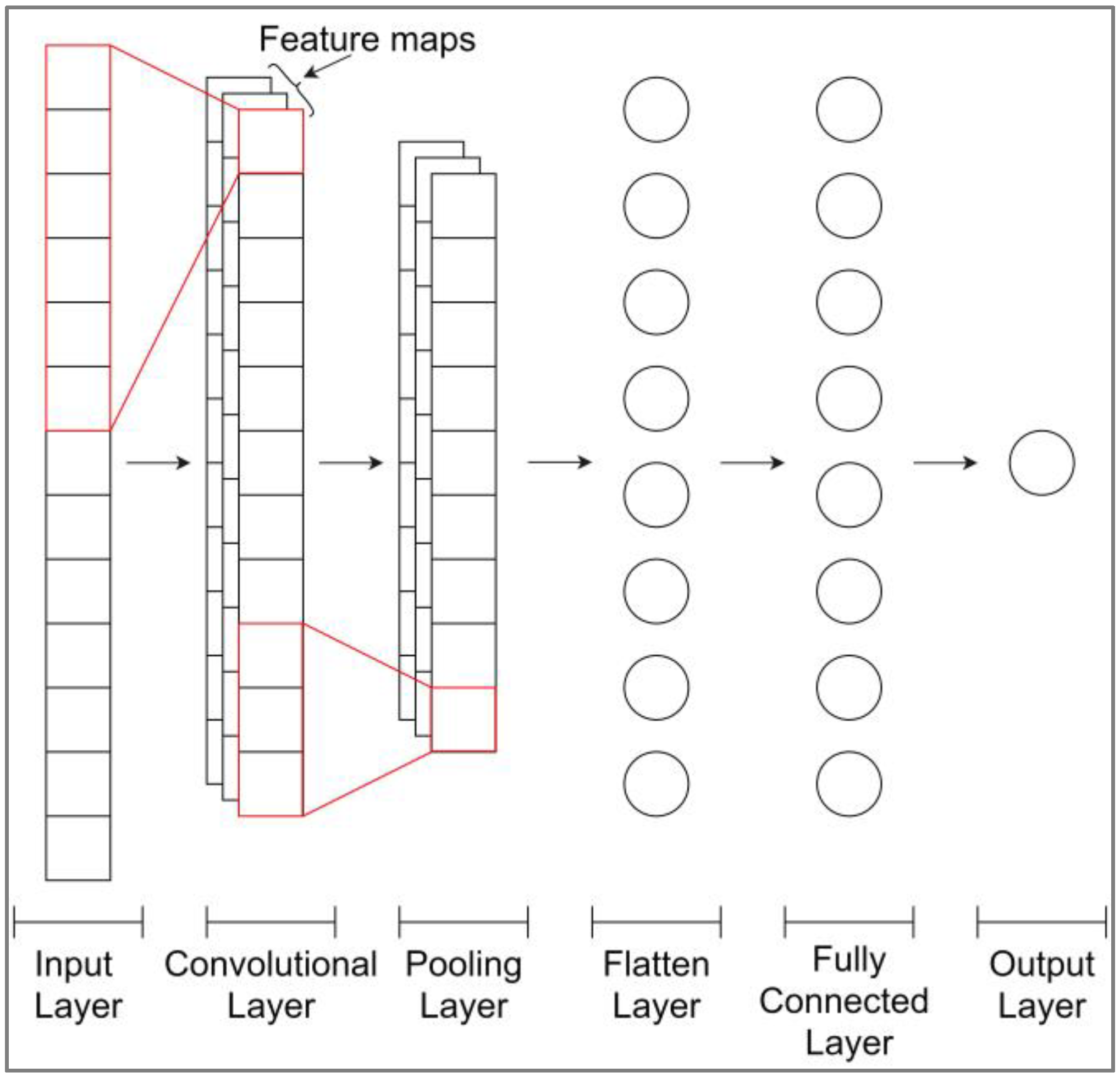


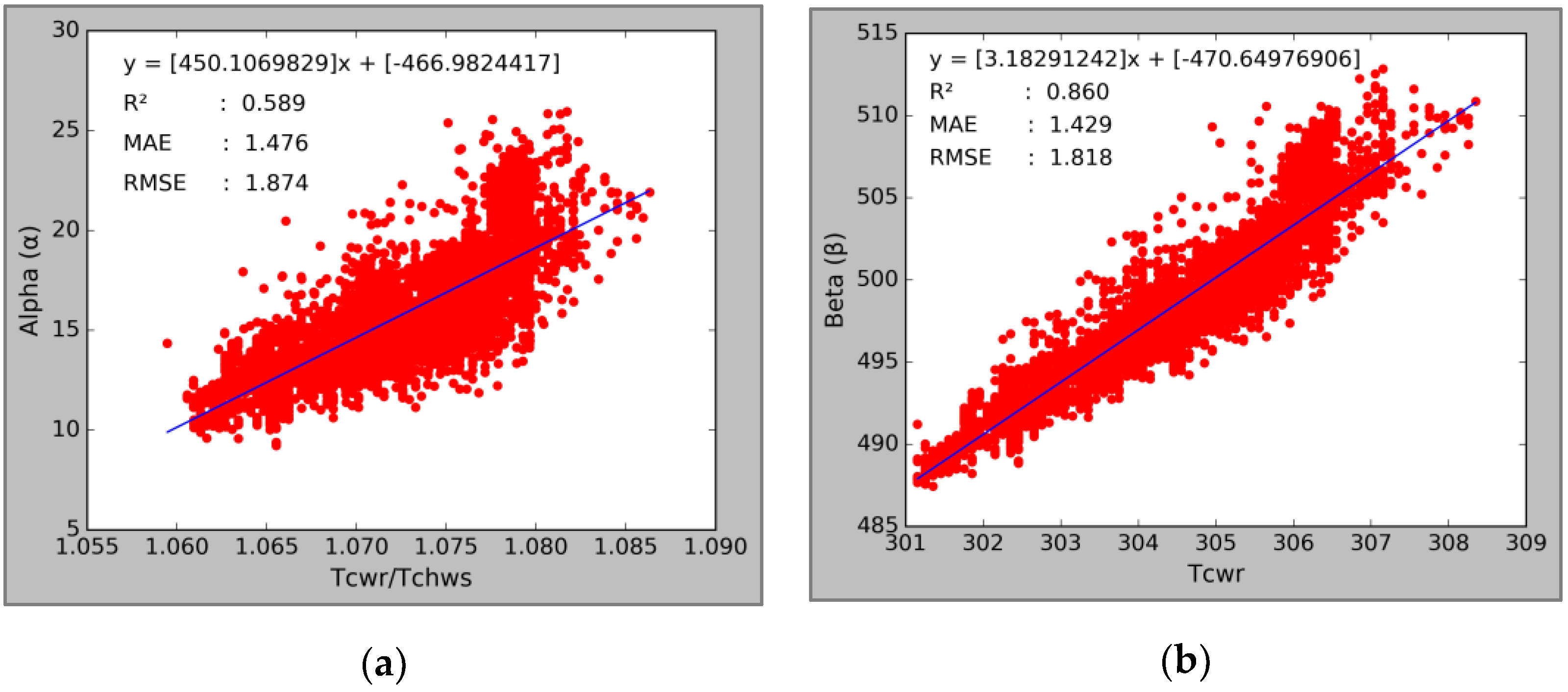
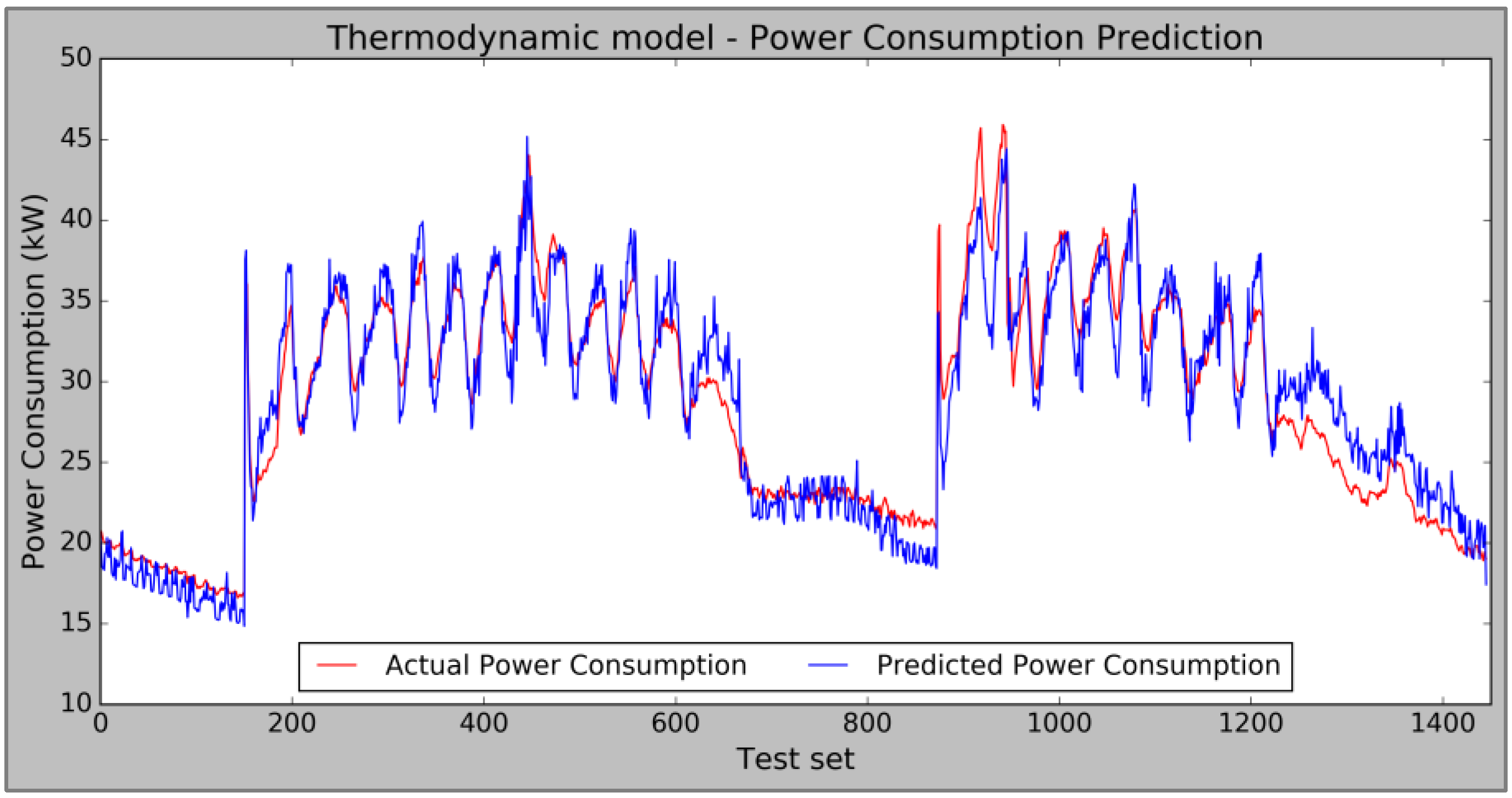

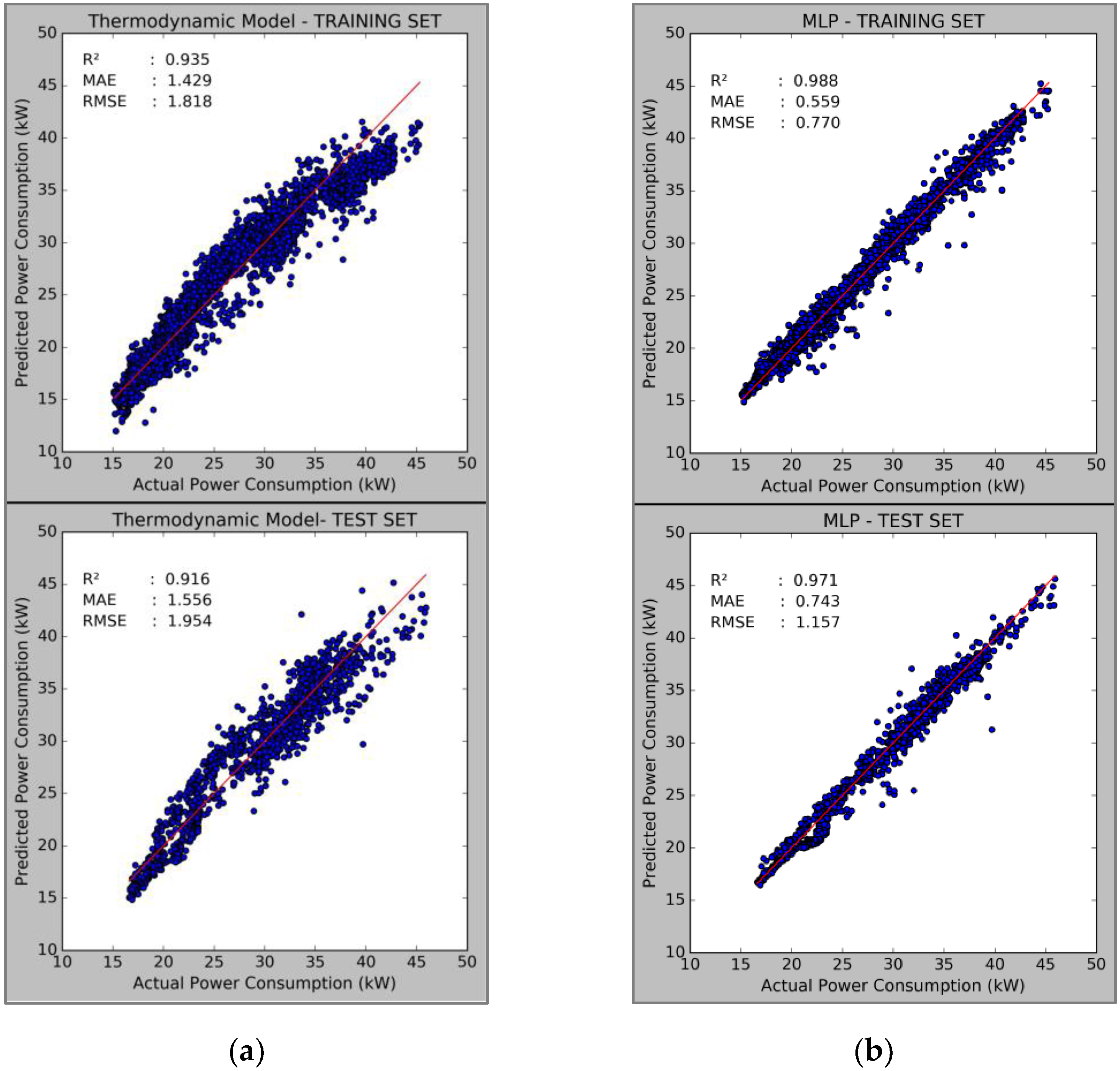
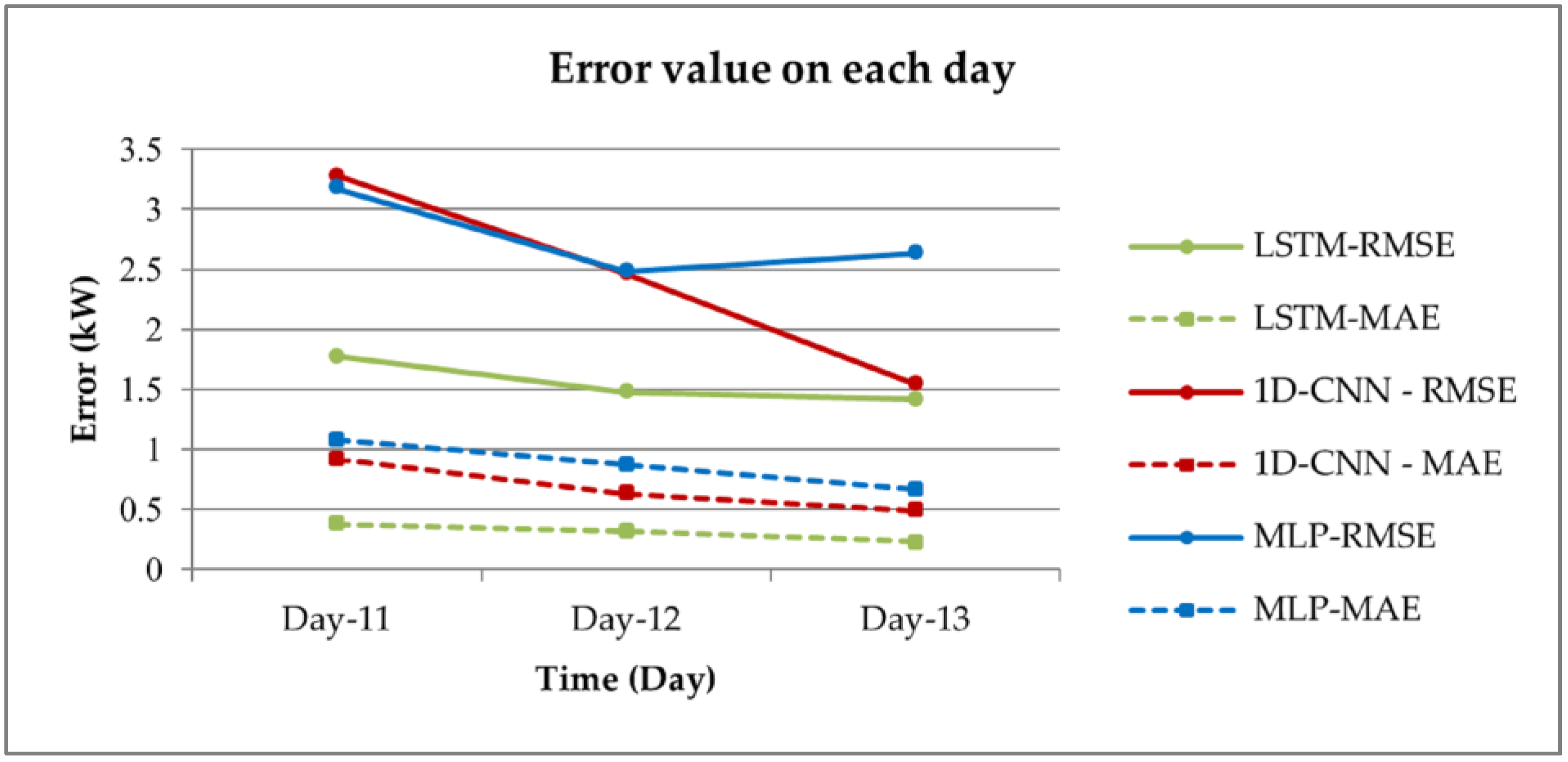
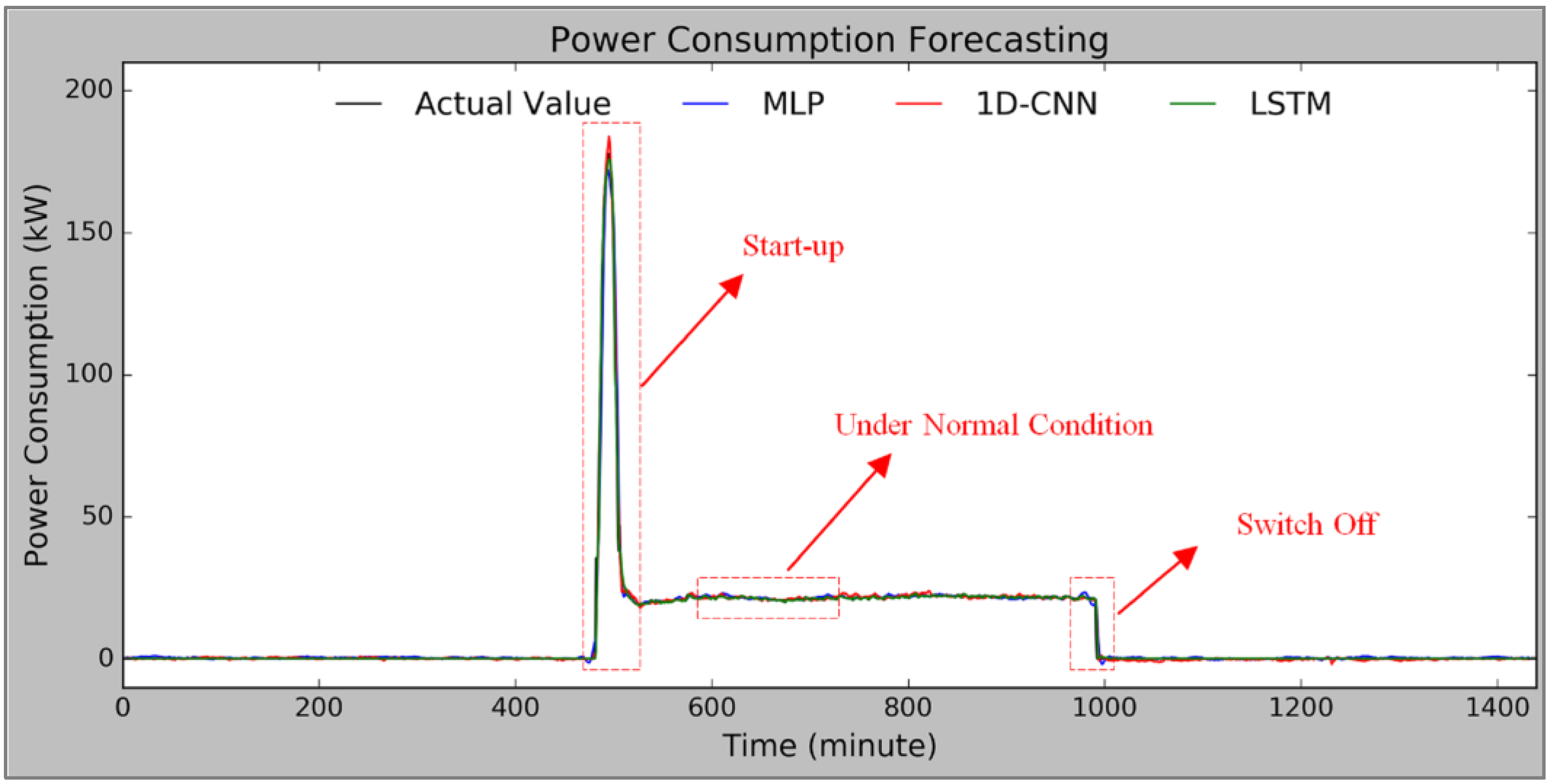

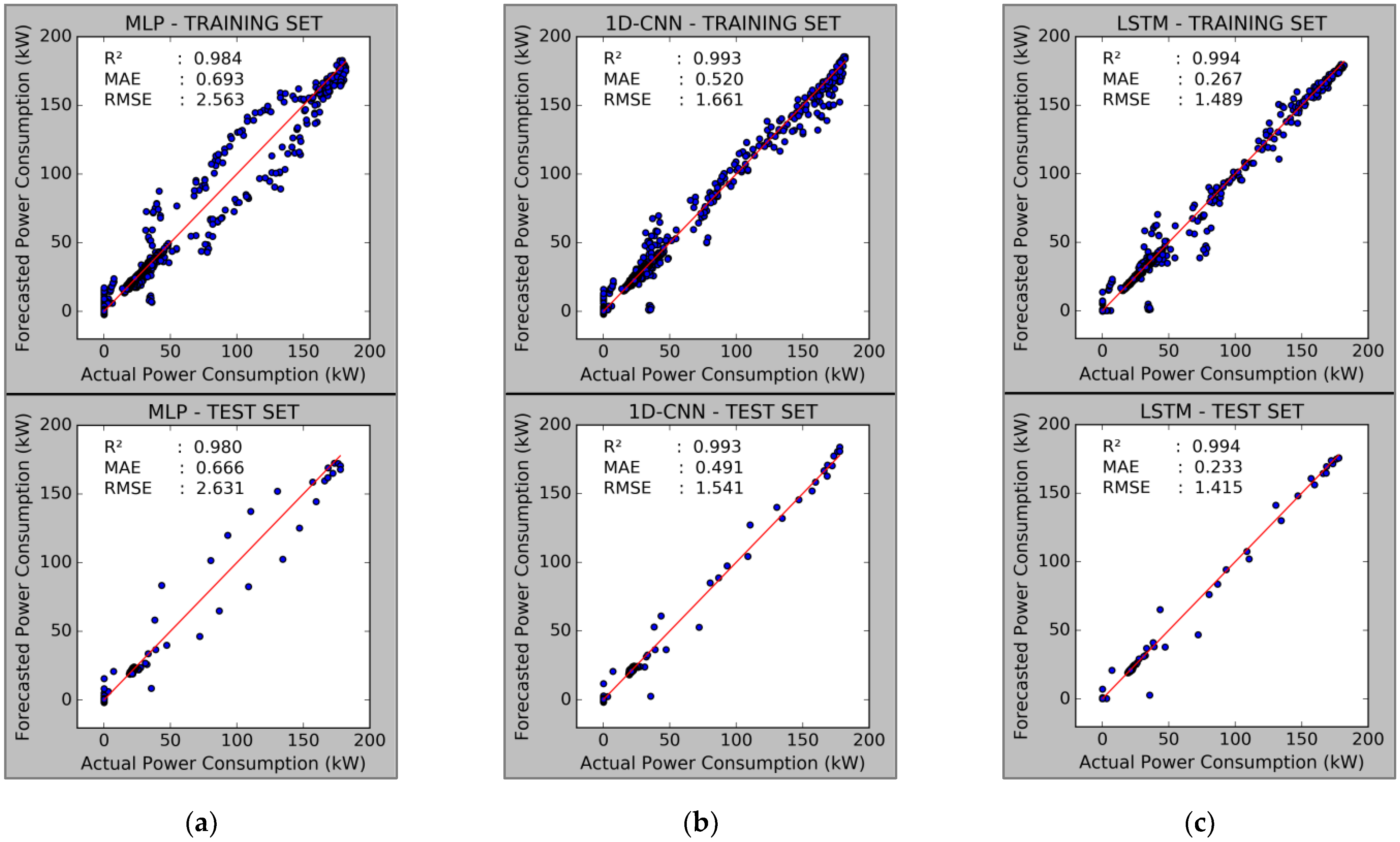
| Compressor Specifications | |
|---|---|
| Compressor model | S6F-30.2 |
| Refrigerant | R22 |
| Power Supply | 230V–3–60Hz |
| Cooling Capacity | 31.7 kW |
| Model | R2 | MAE (kW) | RMSE (kW) | |
|---|---|---|---|---|
| Thermodynamic | Training | 0.935 | 1.429 | 1.818 |
| Test | 0.916 | 1.556 | 1.954 | |
| MLP | Training | 0.988 | 0.559 | 0.770 |
| Test | 0.971 | 0.743 | 1.157 | |
| Model | R2 | MAE (kW) | RMSE (kW) | |
|---|---|---|---|---|
| MLP | Training | 0.984 | 0.693 | 2.563 |
| Test | 0.980 | 0.666 | 2.631 | |
| 1D-CNN | Training | 0.993 | 0.520 | 1.661 |
| Test | 0.993 | 0.491 | 1.541 | |
| LSTM | Training | 0.994 | 0.267 | 1.489 |
| Test | 0.994 | 0.233 | 1.415 | |
Publisher’s Note: MDPI stays neutral with regard to jurisdictional claims in published maps and institutional affiliations. |
© 2021 by the authors. Licensee MDPI, Basel, Switzerland. This article is an open access article distributed under the terms and conditions of the Creative Commons Attribution (CC BY) license (http://creativecommons.org/licenses/by/4.0/).
Share and Cite
Chaerun Nisa, E.; Kuan, Y.-D. Comparative Assessment to Predict and Forecast Water-Cooled Chiller Power Consumption Using Machine Learning and Deep Learning Algorithms. Sustainability 2021, 13, 744. https://doi.org/10.3390/su13020744
Chaerun Nisa E, Kuan Y-D. Comparative Assessment to Predict and Forecast Water-Cooled Chiller Power Consumption Using Machine Learning and Deep Learning Algorithms. Sustainability. 2021; 13(2):744. https://doi.org/10.3390/su13020744
Chicago/Turabian StyleChaerun Nisa, Elsa, and Yean-Der Kuan. 2021. "Comparative Assessment to Predict and Forecast Water-Cooled Chiller Power Consumption Using Machine Learning and Deep Learning Algorithms" Sustainability 13, no. 2: 744. https://doi.org/10.3390/su13020744
APA StyleChaerun Nisa, E., & Kuan, Y.-D. (2021). Comparative Assessment to Predict and Forecast Water-Cooled Chiller Power Consumption Using Machine Learning and Deep Learning Algorithms. Sustainability, 13(2), 744. https://doi.org/10.3390/su13020744





